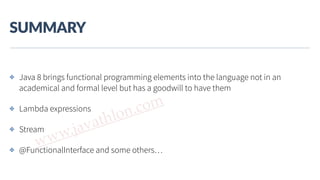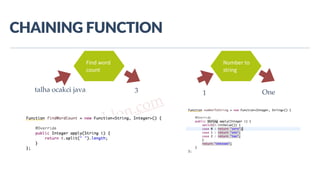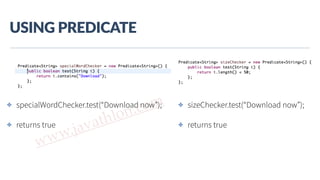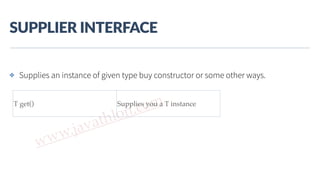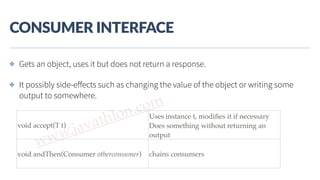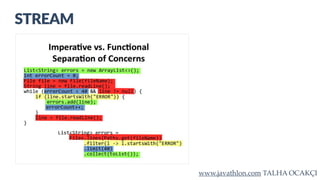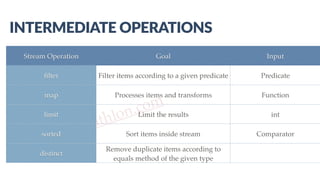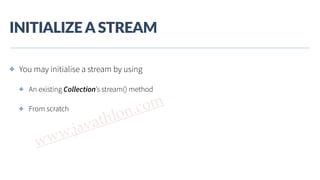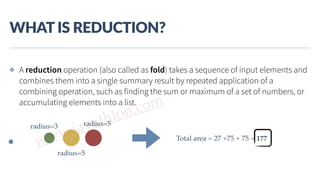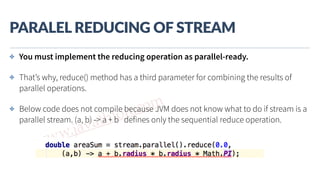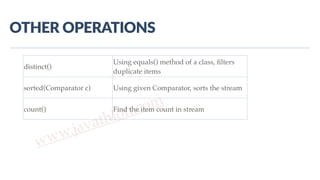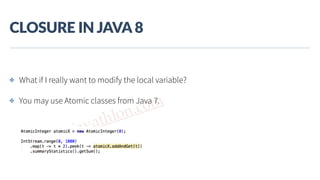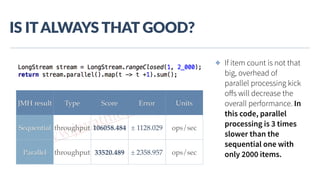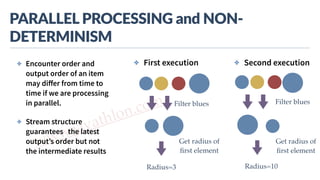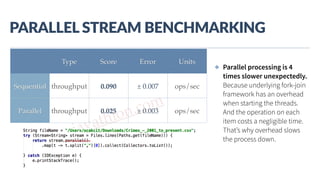Functional programming with Java 8
- 1. TALHA OCAKÇI WWW.JAVATHLON.COM FUNCTIONAL PROGRAMMING IN JAVA 8
- 2. www.javathlon.com GREATEST UPDATE TO JAVA ✤ Inspired by JVM languages such as Scala and Clojure and frameworks like Guava. ✤ Rise of functional programming
- 3. www.javathlon.com WHAT IS FUNCTIONAL PROGRAMMING? ✤ A programming style that treats computation as the evaluation of mathematical functions and avoids changing-state and mutable data. ✤ f(x) = y g(f(x)) = z ✤ Based on lambda calculus. (Some inputs are transformed to some output without modifying the input) ✤ No iteration, no for loop, no variable.
- 4. www.javathlon.com NO ITERATION? ✤ What? Without a for loop, how I will process all elements of an ArrayList? ✤ Yes seems weird. You need to change your mindset. Mind bending at first.
- 5. www.javathlon.com FUNCTION… YOU MEAN METHOD??? ✤ No, I don’t mean the methods inside a class. ✤ FUNCTION IS NOT METHOD! ✤ Methods are not independent program units and they are bound to another context, like an object instance or class. ✤ Methods may depend upon values other than its arguments ✤ Methods may change the values of its arguments or some other static values. ✤ Pure functions are opposite.
- 6. www.javathlon.com WHAT IS A FUNCTION? ✤ Lives independently ✤ Does not depend to any value other than its arguments ✤ Output of a function is a value or another function ✤ Does not change any argument’s value or any other external value. (no side effects) ✤ Functions may be composed together regardless of the context
- 7. www.javathlon.com WHAT IS FUNCTIONAL PROGRAMMING ✤ Functions exist independently. Not bound to objects or classes ✤ Functions can not change the state of any object or value ✤ All values are immutable. Hates mutability! ✤ No iteration. Operations are done by recursion.
- 8. www.javathlon.com Why so afraid of mutability? Did you ever wonder why most solutions to program glitches are fixed by rebooting your computer or restarting the offending application? That’s because of state. The program has corrupted its state.
- 9. www.javathlon.com Why so afraid of mutability? ✤ Do you remember synchronised keyword, Barriers, Semaphores, Locks and their lack of sweetness? ✤ Have you ever scratched your hair because of deadlocks, thread starving, unexpected values of non-atomic object operations? ✤ We created the devil, intentionally, ourselves. We! Phew! Why?
- 10. www.javathlon.com How to prevent multithread problems? ✤ Prevent mutability ✤ If mutability is important, put the synchronisation block in the object. ✤ Use AtomicInteger instead of Integer ✤ Use ConcurrentHashMap instead of HashMap…
- 11. www.javathlon.com MULTICORE SUPPORT AND THREAD SYNCHRONIZATION IN JAVA ✤ Fork/Join for multicore in Java ✤ Thread and ThreadPool for multi-thread ✤ Leverage all cores of CPU. Distribute the tasks each core and then combine the results.
- 12. www.javathlon.com BIG-‐DATA AND MAP-‐REDUCE ✤ Huge data is processed in chunks, each chunk yields an intermediate form of data. ✤ Intermediate data is combined into single result. ✤ None of the functions may affect each other but simply yield a single result without a side effect.
- 13. www.javathlon.com BIGDATA AND MAP-‐REDUCE Mapper Combinator
- 14. www.javathlon.com BIGDATA AND MAP-‐REDUCE ✤ Each operation must be an independent pure function. ✤ So, functional programming is cut out for these type of problems.
- 15. www.javathlon.com TALHA OCAKÇI FUNCTIONAL OBJECT ORIENTED JAVA 8 Where is functions? Independent Bound to object or classes. Called as method. Functional interface (Seems independent but bound to object or class again) Value state Immutable Mutable Immutable if you desire Function chaining Yes Yes if in same instance Lambda functions may chain Synchronization and multicore support Great!!! Exist but really a cumbersome So much easy than Java 7.
- 17. www.javathlon.com ELEMENTS OF FUNCTIONAL PROGRAMMING ✤Immutable state (yes, get rid of mutable state, the evil.) ✤No side effects of function apply. (Input arguments are not modified) ✤No iteration. Only recursion ✤Function references and function compositions ✤Higher order functions(functions may be passed as arguments to other functions) and currying (partial evaluation) ✤Lazy evaluation of collections ✤No null value ✤Closure ✤Monad
- 18. www.javathlon.com JAVA 8 PRETENDS TO BE A FUNCTIONAL PROGRAMMING LANGUAGE Attribute Java 8 Solution (or pretend to be a solution) Immutable state final keyword, Immutable collections (Collections.unmodifiableX). Both make the objects and the collection itself immutable. Declarative. Not imperative Use Streams No iteration. Only recursion No for loop on collections. Instead use Streams and its methods. Function references and function composition All FunctionalInterfaces such as Function, Predicate, Consumer, Supplier interfaces and lambda expressions.
- 19. www.javathlon.com JAVA 8 FUNCTIONAL PROGRAMMING ELEMENTS Attribute Java 8 Solution (or pretend to be a solution) Higher order functions and currying Manuel implementation, no real built-in solution Lazy evaluation of collections take() method of Stream No null value Optional class Monad Stream and Optional … Function Chaining Built-in with Function interface Closure Only with final variables
- 20. www.javathlon.com SUMMARY ✤ Java 8 brings functional programming elements into the language not in an academical and formal level but has a goodwill to have them ✤ Lambda expressions ✤ Stream ✤ @FunctionalInterface and some others…
- 21. www.javathlon.com FINAL -‐ IMMUTABLE OBJECTS ✤ final keyword makes what final? ✤ final Date d = new Date(); ✤ d = new Date() // legal? ✤ d.setTime(23234234); // legal?
- 22. www.javathlon.com FINAL IMMUTABLE OBJECTS ✤ final only protects the address changes. Can not protect state modifications. ✤ You must explicitly protect attributes with private access modifier and then prevent setter methods. ✤ LocalDate is announced as immutable Date object in Java 8.
- 23. www.javathlon.com FUNCTIONAL INTERFACE ✤ Formal definition: Single Abstract Method interfaces ✤ An interface with only one abstract method. ✤ Function, BiFunction, Predicate, Supplier and Consumer interfaces are function interfaces that come or gain importance with Java 8. ✤ Known are Runnable interface with run() method; Comparable with compare() method.
- 24. www.javathlon.com FUNCTIONAL INTERFACES Interface Input Output Goal Function Single object of any type Single object of any type 1. Applying a logic 2. Logic chaining BiFunction Two objects of any type Single object of any type 1. Applying a logic 2. Logic chaining Predicate Single object of any type boolean Tests if a value conforms to a logic Consumer Single object of any type None Using a value and output some side effect Supplier None Single object of any type Create an object of desired type
- 25. www.javathlon.com FUNCTION INTERFACE ✤ Used for creating a an output object based on a given input and the logic and possibly chaining with other functions. ✤ A logic can be packaged as a variable.
- 26. www.javathlon.com FUNCTION INTERFACE ✤ Used for creating a an output object based on a given input and the logic and possibly chaining with other functions. public interface Function<T,R> Layers Tools that allow Layers Tools that allow Apply logic Chain Compose Unit R apply(T t) Applies logic to T and returns an object of R andThen(Function after) First applies its logic then the logic provided by Function after compose(Function before) First applies before logic then its own logic identity() Returns its own input argument
- 28. www.javathlon.com CHAINING FUNCTION Find word count Number to string talha ocakci java 3 1 One We have 2 functions written before
- 29. www.javathlon.com CHAINING FUNCTION Find word count Number to string talha ocakci java One Compose them as returning the word count in a string as text
- 30. www.javathlon.com CHAINING FUNCTION Find word count Number to string talha ocakci java 3 1 One
- 31. www.javathlon.com CHAINING FUNCTION Simple Function invocation: findWordCount.apply(“talha ocakci java”) => 3 numberToString.apply(2) => “two” Function Chaining findWordCount.andThen(numberToString).apply(“talha ocakci java”) => “three” Find word count Number to string talha ocakci java 3 3 “three” andThen
- 32. www.javathlon.com FUNCTION CHAINING RULE ✤ Output type of first function must be a super class or the same class of the input of second function’s input Find word count Number to string talha ocakci java 3 3 “three” andThen
- 33. www.javathlon.com FUNCTION CHAINING RULE ✤ Otherwise ClassCastException is thrown. Uppercase sentence Number to string talha ocakci TALHA OCAKCI ???? andThen TALHA OCAKCI
- 34. www.javathlon.com PREDICATE ✤ Tests if a data conforms to some value or logic ? = is yellow true = valid false = not valid
- 35. www.javathlon.com PREDICATE INTERFACE ✤Tests if a data conforms to some value or logic ✤Logical operations can be used public interface Function<T,R> Layers Tools that allow Layers Tools that allow Test data or Negate and boolean test(T t) Tests if t conforms to a logic and(Predicate otherPredicate) Logical and operation with another predicate or(Predicate otherPredicate) Logical or operation with another predicate negate() Logical not operation
- 36. www.javathlon.com USING PREDICATE ✤ First predicate tests if given string has word “Download” ✤ Second predicate tests if text’s length is less than 50.
- 37. www.javathlon.com USING PREDICATE ✤ specialWordChecker.test(“Download now”); ✤ returns true ✤ sizeChecker.test(“Download now”); ✤ returns true
- 38. www.javathlon.com LOGICAL OPERATIONS ON PREDICATE ✤ Check if the string has less than 50 characters and contains word download by using existing Predicates ✤ sizeChecker.and(specialWordChecker).test(“Download now”)
- 39. www.javathlon.com SUPPLIER ✤ Supplies an instance of given type by constructor or some other ways. .
- 40. www.javathlon.com SUPPLIER INTERFACE T get() Supplies you a T instance ✤ Supplies an instance of given type buy constructor or some other ways.
- 42. www.javathlon.com CONSUMER ✤ Gets an object, uses it but does not return a response. ✤ It possibly side-effects such as changing the value of the object or writing some output to somewhere. . write something to somewhere
- 43. www.javathlon.com CONSUMER INTERFACE void accept(T t) Uses instance t, modifies it if necessary Does something without returning an output void andThen(Consumer otherconsumer) chains consumers ✤ Gets an object, uses it but does not return a response. ✤ It possibly side-effects such as changing the value of the object or writing some output to somewhere.
- 45. www.javathlon.com LAMBDA EXPRESSIONS ✤ Simplifying the usage of Function, Predicate, Consumer, Supplier interfaces lambda expressions are used. ✤ All methods of these interfaces may be changed with these : -> ✤ This expression may be referred with the proper interface reference. ✤ JVM understands which method to use.
- 46. www.javathlon.com CONVERTING A DEFINITION TO LAMBDA EXPRESSION t -> t.contains(“Download”)
- 47. www.javathlon.com VALID LAMBDA EXPRESSIONS (parameters) -> expression (List<String> list) -> list.isEmpty() (parameters) -> {return … ;} (int a, String b) -> { System.out.println(a); return b +a ; } }(parameters) -> statements (int a, int b) -> a * b (parameters) -> statements (int a, int b) -> {return a * b;}
- 48. www.javathlon.com LAMBDA EXPRESSIONS ✤ -> automatically detects the proper interface, according to the return value and then invokes the proper method. ✤ t -> t.contains(“Download”) ✤ Since right hand side returns a boolean, JVM understands that it should use a Predicate. So implicitly creates a Predicate and then invoke test() method.
- 49. www.javathlon.com LAMBDA EXPRESSIONS ✤ -> automatically detects the proper interface, according to the return value and then invokes the proper method. ✤ t -> System.out.println(“t + “is my string””) ✤ Since right hand side returns nothing, JVM implicitly creates a Consumer and invokes apply method automatically.
- 50. www.javathlon.com LAMBDA EXPRESSIONS ✤ -> automatically detects the proper interface, according to the return value and then invokes the proper method. ✤ t -> t * 3; ✤ Since right hand side accepts an input and returns a value, JVM implicitly creates a Function instance and invoke apply method automatically.
- 51. www.javathlon.com REFERRING TO A LAMBDA EXPRESSION
- 52. www.javathlon.com REFERENCING TO LAMBDA EXPRESSION ✤ This fails because right hand side of lambda returns nothing. Then it is not a Function but Consumer. Thus, below reference is correct.
- 53. www.javathlon.com REFERENCING TO A FUNCTION 1 2 3
- 54. www.javathlon.com FUNCTION CURRYING ✤ Currying is evaluating function arguments one by one, producing a new function with one argument less on each step.
- 55. www.javathlon.com METHOD AND CONSTRUCTOR REFERENCES ( :: operators ) ✤ You don’t have to write a function from scratch every time. You may refer to a method or constructor of a class or instance. ✤ :: operator is used for accessing static method of a class or an instance method
- 56. www.javathlon.com AVOIDING NULL ✤ Null is a value that is not actually a value. ✤ Hard to determine whether the value not present or just has no value ✤ Null is mentioned as “millon dollar mistake” ✤ Functional programming avoids null ✤ Instead, each language has a structure for determining if a reference holds a real value or not. ✤ It is Optional in Java.
- 57. www.javathlon.com OPTIONAL ✤ In functional programming, we chain functions. If somewhere in the chain, null is obtained, NullPointerException may be thrown. ✤ Between the chain items, we should be able to check if a value present. ✤ This is done by ifPresent() method of an Optional instance. A value exists inside? Yes, take it No, do you want me to supply something else?
- 58. www.javathlon.com OPTIONAL ✤ Optional<String> myOptional = Optional.of(“test”); ✤ This says, a string may exist inside. get it with get() method ✤ If a value presents get it, or supply it with something else getOrElse(Supplier s) ✤ Check if a value presents with isPresent() ✤ Do something if value presents ifPresent(Consumer consumer)
- 60. www.javathlon.com TALHA OCAKÇI Collection Stream maker Collection+ + + Copy the reference and pass stream funnel one by one + ✤ Stream is the structure for processing a collection in functional style. ✤ Original collection is not modified. ✤ Stream may be processed only once. After getting an output you can not use it again. STREAM
- 61. www.javathlon.com TALHA OCAKÇI Stream maker Filter reds Make them triangle with same area Filter small triangles Sum up circumferences 20 You may stop processing in any of these steps
- 62. www.javathlon.com STREAM IN JAVA 8 Each of these boxes is an functional interface: Function, Mapper, Supplier, Consumer, Predicate Stream may be created with stream() method of Collection. 20
- 63. www.javathlon.com INTERMEDIATE AND TERMINAL OPERATIONS ✤ Intermediate operations yield a new Stream and you may pipeline(chain) the operations ✤ Terminal operations yield a result other than a stream: A list, Integer etc… ✤ After a terminal operation, you can not use the stream again and you can not pipeline another function. Intermediate operations Terminal operations
- 64. www.javathlon.com INTERMEDIATE OPERATIONS Stream Operation Goal Input filter Filter items according to a given predicate Predicate map Processes items and transforms Function limit Limit the results int sorted Sort items inside stream Comparator distinct Remove duplicate items according to equals method of the given type
- 65. www.javathlon.com TERMINAL OPERATIONS STREAM OPERATION GOAL INPUT forEach For every item, outputs something Consumer count Counts current items collect Reduces the stream into a desired collection
- 66. www.javathlon.com INITIALIZE A STREAM ✤ You may initialise a stream by using ✤ An existing Collection’s stream() method ✤ From scratch
- 67. www.javathlon.com CONVERTING COLLECTIONS TO STREAM ✤ You may use stream() method of any collection. ✤ Original collection is not effected during the process ✤ You can’t process a stream after you get an output. Collection Stream maker +
- 68. www.javathlon.com CONVERTING COLLECTIONS TO STREAM
- 69. www.javathlon.com CREATE STREAM FROM SCRATCH ✤ You may use of() method of stream. Put the values as comma separated. ✤ Use IntStream, DoubleStream, LongStream and range() method of them.
- 70. www.javathlon.com FILTER ✤ Includes the items that conform to given Predicate and creates a new stream. ? = is yellow true = valid false = not valid
- 71. www.javathlon.com MAP ✤ All items are converted to a new state or a new type. ✤ Logic is assigned with a Function.
- 72. REDUCTION Combining items according to a logic
- 73. www.javathlon.com WHAT IS REDUCTION? ✤ A reduction operation (also called as fold) takes a sequence of input elements and combines them into a single summary result by repeated application of a combining operation, such as finding the sum or maximum of a set of numbers, or accumulating elements into a list. radius=3 radius=5 radius=5 Total area = 27 +75 + 75 = 177
- 74. www.javathlon.com REDUCING THE STREAM i1 => radius=3 i2 => radius=5 i3 => radius=5 result = Initial value result = f(result, i1) result = f(result, i2) result = f(result, i3) f(a, b) = a + (b.radius)*(b.radius)*PI f(0, i1) = 0 + 3 *3 * 3 = 27 f(27, i2) = 27 + 5* 5*3 = 102 f(102, i3) = 102 + 5*5*3 = 177
- 75. www.javathlon.com REDUCING THE STREAM i1 => radius=3 i2 => radius=5 i3 => radius=5 result = Initial value result = f(result, i1) result = f(result, i2) result = f(result, i3) stream. reduce(initial_value, f(a, b)) stream. reduce(0, (a,b) -> a + b * b * PI) This would be enough if operations were sequential only. But streams must be processable in parallel.
- 76. www.javathlon.com PARALEL REDUCING OF STREAM ✤ You must implement the reducing operation as parallel-ready. ✤ That’s why, reduce() method has a third parameter for combining the results of parallel operations. ✤ Below code does not compile because JVM does not know what to do if stream is a parallel stream. (a, b) -> a + b defines only the sequential reduce operation.
- 77. www.javathlon.com PARALLEL REDUCE STREAM ✤ The third parameter is the accumulator and defines how to combine the intermediate results of several threads. 5 53Thread 1 Thread 2 0 0 + 3*3*PI = 27 27 + 5*5*PI =112 0 0 + 5 * 5 *PI =75 0 + 112 = 112 112 + 75 = 189 Combiner function 0
- 78. www.javathlon.com PARALLEL REDUCE STREAM 5 53Thread 1 Thread 2 0 0 + 3*3*PI = 27 27 + 5*5*PI =112 0 0 + 5 * 5 *PI =75 0 + 112 = 112 112 + 75 = 189 Combiner function 0 Combiner function Accumulator function Initial seed for both functions
- 79. www.javathlon.com OTHER OPERATIONS distinct() Using equals() method of a class, filters duplicate items sorted(Comparator c) Using given Comparator, sorts the stream count() Find the item count in stream
- 80. www.javathlon.com COLLECTOR ✤ Collector is a reducer operation. ✤ Reducer: takes a sequence of input elements and combines them into a single summary result ✤ Result may be one single collection or any type of one object instance
- 81. www.javathlon.com WHAT COLLECTOR DOES radius=3 radius=5 radius=5 Total area = 27 +75 + 75 = 177 ✤ Gets the desired values of each item, process and returns a single result
- 82. www.javathlon.com WHAT COLLECTOR DOES radius=3 radius=5 radius=5 ✤ Converts the stream into a collection (List, Set, Map). A list as output
- 83. www.javathlon.com COLLECTORS interface Collector<T,A,R> { Supplier<A> supplier() BiConsumer<A,T> accumulator() BinaryOperator<A> combiner() Function<A,R> finisher() Set<Characteristics> characteristics() } supplier: starting object accumulator: - mutable data structure that we will use to accumulate input elements of type T. combiner: used to join two accumulators together into one. used in parallel mode. finisher: takes an accumulator A and turns it into a result value
- 84. www.javathlon.com COLLECTORS.TOLIST() Combiner function Accumulator function Initial seed for both functions ✤ Collectors.toList() collector ✤ Starts with an empty ArrayList ✤ Append each item to this ArrayList in sequential mode ✤ Add each intermediate ArrayList to total ArrayList while combining the results
- 85. www.javathlon.com COLLECTORS ✤ Prebuilt Collector implementations that perform common tasks: ✤ Collectors.toList() Puts items into a list ✤ Collectors.toCollection(TreeSet::new) Puts items into a desired container. Container is supplied with a supplier ✤ Collectors.joining(", “) Joins multiple items into a single item by concatenating them ✤ Collectors.summingInt(item::getAge) Sums the values of each item with given supplier ✤ Collectors.groupingBy() Groups the items with given classifier and mapper ✤ Collectors.partitioningBy() Partitions the items with given predicate and mapper
- 86. www.javathlon.com EXAMPLE Salary:1000 Department: HR Salary:3000 Department: Admin Salary: 5000 Department:Admin Salary:2000 Department: HR Salary:3000 Department: Admin Salary: 5000 Department:Admin Salary:1000 Department: HR Salary:2000 Department: HR 4000 4000 partioningBy Find average salary of each department averagingInt
- 87. www.javathlon.com RESULT OF GROUPING BY Salary:3000 Department: Admin Salary: 5000 Department:Admin Salary:1000 Department: HR Salary:2000 Department: HR List<Employee> List<Employee> Map<String, List<Employee>> key
- 88. www.javathlon.com PIPELINING REDUCERS Salary:4000 Salary: 5000Salary:3000 Salary:2000 Map<String, List<Employee>> Map<String, Double>> 5000.0 9000.0 groupingBy summingDouble
- 89. www.javathlon.com PEEKING INTERMEDIATE RESULTS 20 peek the result without waiting the next operations
- 90. www.javathlon.com PEEKING ELEMENTS ✤ In any intermediate operation, you may get the intermediate result. ✤ Below code, adds each item in stream after they are multiplied by two.
- 91. www.javathlon.com CLOSURE ✤ Closure means that, if a method contains another method; outer variables should be accessible to the inner method. Image is from: http://stackoverflow.com/questions/36636/what-is-a-closure
- 92. www.javathlon.com CLOSURE IN JAVA 8 ✤ A lambda expression is a function. So A lambda expression should be able to access the variables in outer scope ✤ We may access but only if this variable is final (read-only)
- 93. www.javathlon.com CLOSURE IN JAVA 8 ✤ What if I really want to modify the local variable? ✤ You may use Atomic classes from Java 7.
- 94. PARALLELISM Automa?c usage of fork-‐join framework
- 95. www.javathlon.com PARALLEL STREAMS ✤ Parallel streams automatically distribute the tasks to several cores and combine the results by using fork-join framework.
- 96. www.javathlon.com PARALLEL STREAMS BENCHMARKING ✤ Benchmarking is done by JMH library. ✤ JMH library warms up the JVM with 10 iterations and then 10 real iteration. ✤ Calculates in one second, how many times this method can be completed. Because I have selected the output type as “throughput”. ✤ The only difference in compared codes is the sequential stream processing and parallel stream processing.
- 97. www.javathlon.com PARALLEL PROCESSING JMH result Type Score Error Units Sequential throughput 0.711 ± 0.011 ops/sec Parallel throughput 2.260 ± 0.424 ops/sec Parallel stream operated 3 times faster with 2 billion items.
- 98. www.javathlon.com PARALLEL PROCESSING JMH result Type Score Error Units Sequential throughput 0.526 ± 0.006 ops/sec Parallel throughput 1.845 ± 0.054 ops/sec max() operation also operated 3 times faster in parallel mode with 2 billion items.
- 99. www.javathlon.com IS IT ALWAYS THAT GOOD? ✤ If item count is not that big, overhead of parallel processing kick offs will decrease the overall performance. In this code, parallel processing is 3 times slower than the sequential one with only 2000 items. JMH result Type Score Error Units Sequential throughput 106058.484 ± 1128.029 ops/sec Parallel throughput 33520.489 ± 2358.957 ops/sec
- 100. www.javathlon.com .parallel() miracle? ✤ You invoke parallel() method on the stream and expected a true and faster process. If so, you will be miserable. ✤ You must first ✤ transform your code into thread-safe structure. ✤ reduce blocking parts of the code ✤ obey the rules of monads in your code
- 101. www.javathlon.com PARALLEL PROCESSING and NON-‐ DETERMINISM Radius=10 Filter blues Get radius of first element Radius=3 Filter blues Get radius of first element ✤ First execution ✤ Second execution✤ Encounter order and output order of an item may differ from time to time if we are processing in parallel. ✤ Stream structure guarantees the latest output’s order but not the intermediate results
- 102. www.javathlon.com PARALLEL STREAM BENCHMARKING Type Score Error Units Sequential throughput 0.090 ± 0.007 ops/sec Parallel throughput 0.025 ± 0.003 ops/sec ✤ Parallel processing is 4 times slower unexpectedly. Because underlying fork-join framework has an overhead when starting the threads. And the operation on each item costs a negligible time. That’s why overhead slows the process down.
- 103. www.javathlon.com PARALLELISM ON CPU-‐BOUND OPERATIONS Score Error Units Sequential 0.085 ± 0.003 ops/sec Parallel 0.258 ± 0.008 ops/sec Now, parallel processing is faster. Because the process time on each item is much more than fork-join overhead.
- 104. www.javathlon.com CONCLUSION -‐ WHEN TO GO PARALLEL? ✤ If our process is not IO-bound. ✤ If process for each item is CPU-bound and ✤ If duration of each process * item count > fork-join overhead ✤ Benchmark your operations before going parallel.
- 105. www.javathlon.com PARALLELISM ON STATEFUL OPERATIONS Stateful operations such as distinct and sort harms parallelism. Score Error Units Sequential 0.008 ± 0.001 ops/sec Parallel 0.008 ± 0.002 ops/sec
- 106. www.javathlon.com CONCLUSION -‐ WHEN TO GO PARALLEL? ✤ If most of the operations are stateless such as map and filter. If sort, distinct methods are used, multiple passes or data caching will be required. Bad for parallelism because laziness can not be leveraged. ✤ When source collection is efficiently splittable such as ArrayList or Array.




















